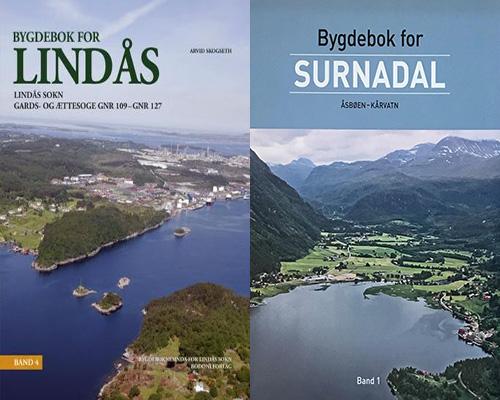Norwegian Genealogy
What are Bygdebøker?
There is no central registering agency or standards regarding the production of bygdebøker. They are the product of the local entity they document.
Bygdebøker are secondary sources and could present some research errors. The strongest volumes will contain birth, marriage, and death information, documentation of land transactions, and will provide comprehensive biographical information – often including photographs.
Finding Guides
We have been collecting Bygdebøker since 2023. You can use our look-up request form to submit requests for pages.
Guides exist for:
- Region, District, Historic Kommune
- Historic Kommune, District, Region
A guide Gards (Farm Estates) is in the works and will be available later in 2024.
Research Information
Because there are no standards, the use of the term Bygd or Bygdebøk in the titling of books is inconsistent. Contents of these resources can often, but not always, be identified from the title of the work. Some examples of titles include:
- Gårds- og ættesoge
- Gårds- og slektshistorie
- Gård og slekt
- Gårdar og Folk
- Bygdesoge
- Gardshistorie
- Heim og Folk
- Bosettings- og Næringshistorie
- Gard og Grend
Books which contain the term Gårds in their title are typically farm histories. These will often contain Gårdsnummers as identifiers for what Gårds are covered by a particular volume.
A Bygdesoga (Bygd Story) or Allmennhistoria (General History) will contain less genealogical information and more local history. Often the volumes will include date ranges of coverage.
Some volumes contain genealogical information but don't concentrate on farms. Titles such as Heim of Folk (Home and People) or Fortid og Folk (Past and People) aren't necessarily farm books, but likely contain genealogical information.
Norway developed the Norwegian Land Registry system in order to document property ownership. The Norwegian system assigns numbers to each property based on the type of land it is:
- Fylkesnummer - A Fylke or Fylker is the county. Prior to 1918, it was Amter (Amt.)
- Kommunenummer – A Kommune is a municipality.
- Gårdsnummer (Gnr.) - a Farm unit
- Bruksnummer (Bnr.) – a new farm unit
- Festenummer (Fnr.) – a rental plot within a Bruks
- Seksjonsnummer (Snr.) – individual units on one shared property, like condominiums.
The Land System is a necessary component to using bygdeboker. As you begin to research, you will quickly discover that bygdeboks which cover gards (farms) are typically volumized by a series of gårdsnummer and organized in the table of contents by bruksnummer. In some cases, they will be broken down further by festenummer or seksjonsnummer.
Very few bygdebøker are available digitally. While the Norwegian National Library has performed a digitization project – it restricts access to only Norwegian IP addresses. Familysearch has digitized some volumes – but they remain locked due to Norwegian law. More than likely, researchers will need to locate a print copy.
St. Louis County Library
St. Louis County Library is actively collecting Bygdebøker. Selection determinations are made based on Norwegian copyright law which protects materials for 70 years + life of the author. The majority of items in SLCL's collections will have been published since 1960 with a few items dating prior to that timeframe. SLCL has standing orders with many Norwegian Kommunes for the most modern volumes and offers free look-ups from Indexed sources.
Other Large Collections
University of North Dakota
The Arne G. Brekke Bygdebok Collection at the University of North Dakota possesses the most comprehensive collection of bygdeboks in the United States. They have developed a useful finding aid and research guide. The collection is a research collection and may be accessed on-site or they will provide research assistance for a fee. They do not circulate these materials. Collections include some earlier titles which precede SLCL copyright restrictions.
Norwegian American Genealogical Society
The Naeseth Library at the Norwegian American Genealogical Center in Madison, WI houses one of the country’s largest collections of Norwegian and Norwegian-American family history, genealogy, and immigration history resources. This includes a large collection of bygdeboks.
University of Minnesota
The University of Minnesota has a moderate sized collection of bygdeboker. The University is not actively collecting these resources. Collections include some earlier titles which preceed SLCL's copyright restrictions. They do offer Inter-library loan service for particular volumes.
Library of Norway
The Library of Norway has the most comprehensive collection of bygdeboker in the world. They have digitized all volumes and made them available to Norwegian citizens with a Norwegian IP address. While non-Norwegians cannot access the digitized books, the catalog is available to search. This is a great way to identify if a publication has been produced for the area genealogists are seeking to research.
There are several root terms researchers can key in on to identify the content of a particular Bygdebok:
- gard or gård or gardar or garden - spelling is regionally dependent – a country estate or a farm
- Bruks - small farm or tenant farm within a Gård
- ættesoge - Genealogy
- slekt - Family
- slekthistorie - Family History
- soge - Story
- Bygdesoge - Settlement Story
- Grend - Hamlet (an historical farm unit that was acquired by a larger farm).
Map Guide to Bygdeboker
Map locations of Bygdeboker held in the our collection.
Items are organized by the Five Regions:
- Vestlandet (West)
- Østlandet (East)
- Trøndelag (Central)
- Nord-Norge (North)
- Sørlandet (South)
Each entry contains the name of the current Kommune (Municipality) and Fylke (County). They are color coded by Fylke.
Items in Gray are currently on order and will be updated when made available.


